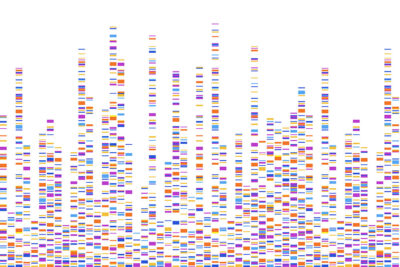 Exploring human evolution via DNA was essential for twentieth-century evolution scientists. Charles Darwin, however, in The Origin of Species, never used the terms genetics, genetic, and genes until 1872, following the publication of the pea plant inheritance report of Gregor Mendel in 1866.
Exploring human evolution via DNA was essential for twentieth-century evolution scientists. Charles Darwin, however, in The Origin of Species, never used the terms genetics, genetic, and genes until 1872, following the publication of the pea plant inheritance report of Gregor Mendel in 1866.
In his sixth edition, Darwin used the term “genetic” twice, but only to express a genealogical idea, not as a molecular term. In the words of American evolutionary biologist Richard Lewontin,
“Darwin knew nothing about genes.”
English geneticist William Bateson, in a personal letter to colleague Alan Sedgwick, is credited with coining the term “genetics” in 1905, as a molecular term. Since then, “genetics” emerged as the cornerstone of molecular evolutionary biology. Along with examining the fossil record, molecular biologists have been investigating human evolution through the natural selection of DNA.
Max Planck Institute
Researchers at the Max Planck Institute (MPI) for Evolutionary Anthropology in Germany last week published the results of their study in the journal Science entitled “A High-Coverage Genome Sequence from an Archaic Denisovan Individual” in the prestigious Nature journal.
Using a new methodology, the Max Planck research team published the complete DNA genome sequence from a fragmented female finger bone discovered in a Denisova cave in Siberia (pictured right) in 2008. Exploring human 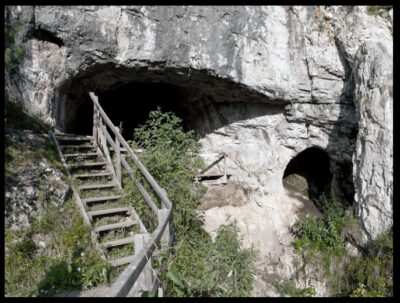 evolution via DNA was publicized in headlines worldwide.
evolution via DNA was publicized in headlines worldwide.
News Story
The Los Angeles Times covered the study with the title “Genome of Ancient Denisovans May Help Clarify Human Evolution.” Pinky DNA Points To Clues About Ancient Humans” was the title of the story posted by NPR news. USA Today, NBC News, FOX News, CBS News, ABC, and BBC News also covered the story. Scientific information concerning human origins captures widespread public attention, and where we came from matters.
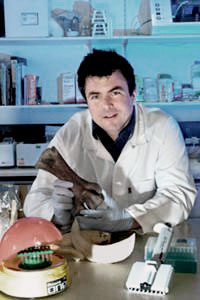 Max Planck’s new methodology enables the examination of DNA that has undergone decay. Their latest method turns a single strand into a double strand of DNA to boost the amount of sample material available to study. Mike Bunce (pictured left), an expert in ancient and degraded DNA from Murdoch University in Western Australia, notes the significance of applying Planck’s new method –
Max Planck’s new methodology enables the examination of DNA that has undergone decay. Their latest method turns a single strand into a double strand of DNA to boost the amount of sample material available to study. Mike Bunce (pictured left), an expert in ancient and degraded DNA from Murdoch University in Western Australia, notes the significance of applying Planck’s new method –
“Now, we’ve got a really detailed genetic code of the Denisovans, Neanderthals, and anatomically modern humans, and we can map out where these interactions occurred.”
Scientists now have an open door to explore human evolution via DNA. The evidence, however, was surprising and unexpected. Bunce notes the study shows “some pretty strong evidence” that Denisovans interbred with humans. Populations of organisms capable of interbreeding define a single species.
Denisova Surprise
“Denisova is a big surprise,” says John Hawks (pictured right), a biological anthropologist at the University of Wisconsin–Madison who was not involved in the research study. Since evolution scientists had anticipated the DNA of 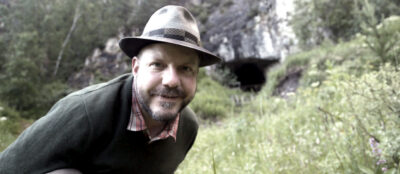 Denisova to be different from Homo sapiens, a potential transitional link, the findings were a surprise.
Denisova to be different from Homo sapiens, a potential transitional link, the findings were a surprise.
The DNA evidence points to interbreeding, not to an isolated reproductive group, as once expected. Self-sustaining reproduction can only occur within a species. By definition, the Denisovans and Homo sapiens, then, represent distinct groups of a single species.
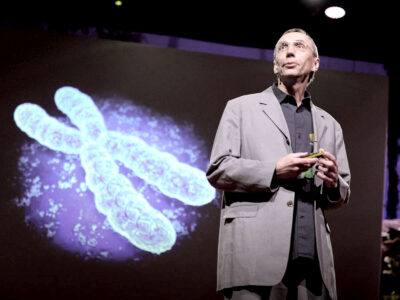 “It was the first time a new group of distinct humans was discovered” via genetic analysis rather than by anatomical description, said Svante Pääbo, a senior researcher at the MPI. Even though the Denisovans are “distinct,” they are “humans” of the same species. The “Denisova Dilemma” continues.
“It was the first time a new group of distinct humans was discovered” via genetic analysis rather than by anatomical description, said Svante Pääbo, a senior researcher at the MPI. Even though the Denisovans are “distinct,” they are “humans” of the same species. The “Denisova Dilemma” continues.
“Indeed, far from supplying ‘a nice clean example of ‘gradualistic evolutionary change,'” according to Casey Luskin in Science & Human Origin,
“The record reveals a dramatic discontinuity between ape-like and human-like fossils. Human-like fossils appear in the record, without clear evolutionary precursors, making the case for human evolution on fossils highly speculative.”
In the words of Ann Gibbons, author of The First Human: The Race to Discover our Earliest Ancestor,
“The story of human evolution has lately become as complicated as a Tolstoy novel.”
Genesis
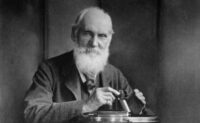 Without DNA or fossil record evidence for transitional “missing links,” Darwin’s dilemma intensifies; the evidence is compatible with the Genesis account written by Moses. William Thomson, 1st Baron Kelvin, an Irish mathematical physicist and engineer, formulated the first and second laws of thermodynamics during the Scientific Revolution, noting –
Without DNA or fossil record evidence for transitional “missing links,” Darwin’s dilemma intensifies; the evidence is compatible with the Genesis account written by Moses. William Thomson, 1st Baron Kelvin, an Irish mathematical physicist and engineer, formulated the first and second laws of thermodynamics during the Scientific Revolution, noting –
“Mathematics and dynamics fail us when we contemplate the Earth, fitted for life but lifeless, and try to imagine the commencement of life upon it… We must pause, face to face with the mystery and miracle of the creation of living creatures.”
Evidence for common ancestry and transitional links underscores why the theory of evolution remains speculative but not scientifically valid.
Exploring Human Evolution via DNA is a Fossil Record article.
Darwin Then and Now is an educational resource on the intersection of evolution and science, highlighting the ongoing challenges to the theory of evolution.
Explore how to understand twenty-first-century concepts of evolution further using the following links –
- The Understanding Evolution category showcases how varying historical study approaches to evolution have led to varying conclusions. Subcategories include –
- Studying Evolution explains how key evolution terms and concepts have changed since the 1958 publication of The Origin of Species.
- What is Science explains Charles Darwin’s approach to science and how modern science approaches can be applied for different investigative purposes.
- Evolution and Science feature study articles on how scientific evidence influences the current understanding of evolution.
- Theory and Consensus feature articles on the historical timelines of the theory and Natural Selection.
- The Biography of Charles Darwin category showcases relevant aspects of his life.
- The Glossary defines terms used in studying the theory of biological evolution.
2020 Update
Max Planck Institute (2013). Denisova’s findings further complicate the cohesive narrative of human evolution.
WIKIPEDIA – regarding “Exploring Human Evolution via DNA”
“So far, the fossils of six distinct individuals from Denisova Cave have been identified through their DNA. Four of the individuals, Denisova 2, Denisova 3, Denisova 4, and Denisova 8, are classified as Denisovans. Denisova 2 and Denisova 3 are young girls, while Denisova 4 and Denisova 8 are adult males. mtDNA analysis of the Denisovan individuals suggests that Denisova 2 is the oldest, followed by Denisova 8, while Denisova 3 and Denisova 4 are roughly contemporaneous.
“One of the individuals, the Altai Neanderthal, is a Neanderthal woman. Before its DNA was sequenced, the Altai Neanderthal had been given the provisional name Denisova 5. In 2018, Denisova 11 was identified as a Neanderthal/Denisovan hybrid based on whole genome sequencing and comparisons.
“During DNA sequencing, Denisova 2, Denisova 4, and Denisova 8 yielded low-coverage genomes, while Denisova 3 and the Altai Neanderthal yielded high-coverage genomes.”
Evolution 101 – regarding “Exploring Human Evolution via DNA”
“Since we first reported on this story in 2010, X-woman’s lineage has been the subject of a flurry of scientific investigations that have reshaped our view of these early human relatives. First, though, a bit of terminology: the lineage has received a new moniker — X-woman is a Denisovan, a name that comes from the cave in which the fossils were first discovered. Further research in that location uncovered two additional Denisovan fossils: teeth. Additionally, scientists have discovered a femur in a Spanish cave that bears genetic ties to Denisovans. Still, there remains uncertainty about which lineage the original owner of this bone belonged to. Human evolution
“Scientists have also delved into the evolutionary history of Denisovans by decoding their entire genome — not just the mitochondrial genes. The bulk of the Denisovan genome (i.e., their nuclear DNA) tells a very different story than their mitochondria do. Though Denisovan mitochondrial DNA is equally closely related to Neanderthal and human mitochondria, the rest of their genome is not. It now appears that Denisovans and Neanderthals are more closely related to each other than either is to Homo sapiens. Human evolution
“The other update on Denisovan evolutionary history is that Denisovans interbred with both Neanderthals (about 17% of Denisovan DNA seems to come from Neanderthals) and ancient humans. Denisovans contributed to the human lineage in their own small way through this interbreeding. The highest percentage of Denisovan DNA in modern humans is found in Melanesian populations, which can trace nearly 5% of their genomes back to Denisovans. As results from newly discovered fossils and ancient DNA accumulate, the human branch of the tree of life is getting bushier, and interbreeding seems to be more common than we had previously thought. This might explain why the Denisovan mitochondrial DNA at first led us astray; perhaps X-woman’s mitochondrial genome was introduced to Denisovans through interbreeding with another, as yet unknown hominin lineage.”
2017 Update – regarding “Exploring Human Evolution via DNA”
“With improvements in DNA technology and better techniques for recovering ancient DNA, we are discovering more genes in modern humans that came to us from our extinct relatives. The percent of human DNA that comes from ancient interbreeding events varies population by population: some modern human genomes contain up to 5% Denisovan DNA.”
Smithsonian Institute – regarding “Exploring Human Evolution via DNA”
2015 – DNA from a Huge Tooth Confirms a New Ancient Cousin
“The Denisovans may have co-existed and interbred with Neanderthals and Homo sapiens.”
2019 – Denisovan Fossil Is Identified Outside Siberia for the First Time
“The results of the investigation not only confirm that Denisovans did, in fact, exist outside of Siberia, but also help fill in gaps in the genetic history of modern Tibetans.”
Comment – By definition, what are called Denisovans, Neanderthals, and Homo sapiens represent distinct groups belonging to a single species without any recognized transitional links.


